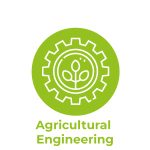Agricultural Engineering
Mitigating soil compaction during sugarcane ratoons by managing the subsoil under residue retention
Last Updated: junio 11, 2025In Colombia, after sugarcane harvests, chisel-type subsoiling implements are used to mitigate soil compaction. Usually, harvest residues are cleared from two interrows that will be decompacted and moved to the adjacent third interrowrrow (2×1 arrangement). However, performing chisel subsoiling operations while preserving residues in all interrows is likely to improve the relationship between the machine-soil-plant system and stimulates sugarcane production.
Potential for the use of machine learning in sugarcane production in Thailand: a review
Last Updated: junio 11, 2025Even though sugarcane is a major agricultural crop in Thailand, Thai sugarcane growers have recently endured high production costs with reduced income. For this reason, there have been many studies to assist farmers to achieve greater efficiencies on-farm. Recently, unmanned aerial vehicle (UAV) technology and machine learning (ML) have been introduced into agriculture.
Relationship between sugarcane area zoning by production levels and soil fertility in Tucumán province, Argentina, using geotechnologies
Last Updated: junio 11, 2025Soil fertility maps enable the detection of areas with different nutrient levels, and identifying environments with varying production levels contributes to zoning and the management of practices that allow for the differential treatment of each zone.
Sectoral collaboration for technological sustainability: The GNSS RTK network in the sugar agro-industry
Last Updated: junio 11, 2025Precision agriculture has transformed the agricultural sector, especially in sugarcane farming, by increasing its efficiency and productivity using self-guided machinery, RTK drones, and robots, However, factors such as uncontrolled traffic, diversity of machinery brands, and differences in instrumentation among machines, alongside with the high cost of RTK mobile stations and the lack of standardization in correction signals, have hindered a widespread adoption of this technology.
Site-specific precision agriculture to improve production in sugarcane
Last Updated: junio 11, 2025At La Estrella sugar mill in Panama, site-specific precision agriculture is being used on some sugarcane blocks where production had declined rapidly by the second-ratoon harvest. The study area is about 150 ha at three sites within the plantation.
Sucrose losses from the field to the mill in a sugar mill in southwestern Colombia
Last Updated: junio 11, 2025This study was carried out during the year 2024, covering all climatic scenarios encountered under normal milling conditions. To identify sucrose losses (Sucrose%Cane), three different scenarios were evaluated: Field, Core Sampler, and Cane Yards, The study involved over 10 sugarcane varieties, with the four most significant varieties being CC05-430, CC01-1940, CC85-92, and CC11-595.
Use of Synthetic Aperture Radar images to assess soil moisture in cane crops: practical implications in agricultural operation
Last Updated: junio 11, 2025The capability of Synthetic Aperture Radar (SAR) technology to estimate soil moisture in sugarcane crops in the Cauca River Valley was evaluated. Given its ability to provide a detailed view of the land surface, SAR emerges as a promising tool for monitoring soil moisture, a critical factor for agriculture.
Using a portable MicroNIR as a key tool for the sugarcane industry
Last Updated: junio 11, 2025Sugarcane companies face challenges in optimizing their harvest timing, as a critical date exists where harvesting achieves maximum efficiency. Missing this date by even a few days can lead to substantial revenue losses. Traditional wet chemistry analyses of limited stalk samples lack representativeness, leading to suboptimal decisions. Industry 4.0T promotes the integration of advanced technologies such as NIR, internet connectivity (IoT) and the processing of data in cloud base type solutions to transform the way sugarcane industry operates, evaluates and produce sugar.
